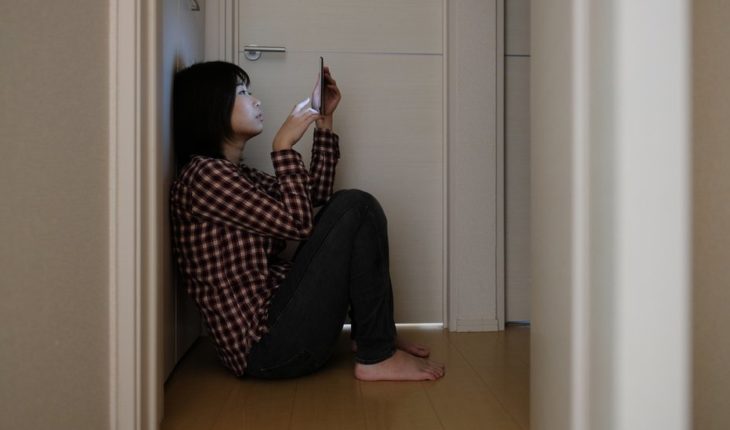KAZUHIRO NOGI/Getty ImagesIkeida, a 55-year Japanese, is a hikikomori. The trend is most common among adolescents. In our hyperconnected world, it can be difficult to disconnect. The endless flow of emails, Tweets, likes, comments and photos keeps us constantly “plugged” to modern life.
But in Japan, half a million people live as modern hermits. They are known as: “hikikomori”: solitary removed all social contact and, often, do not leave your House in years.
A Government survey found that they are about 541,000 people (the 1.57% of the population) in the country, but many experts believe that the total number is much higher, because they sometimes take years to ask for help.
It was thought that this condition was only of Japan, but in recent years it has spread around the world.
In neighboring South Korea, an analysis of 2005 estimated that there were about 33,000 socially isolated adolescent (0.3% of the population) and in Hong Kong a 2014 survey estimated that you reached 1.9% of its population.
And it not only occurs in Asia; It is also happening in United States, Spain, Italy, France and other parts of the world.
A controversial (but usual) subject on investigations into the hikikomori is the influence of modern technology in isolation. It is still far from any potential link between these two phenomena, but are concerned that the ‘lost generation’ of Japan can be a call to attention of our increasingly unconnected societies.
The term hikikomori refers both to the condition and sufferers and was coined by the Japanese psychologist Tamaki Saito in his book “social isolation: an endless adolescence” (1998).
Getty ImagesEl “hikikomori” can be described as a teenager that has no end. Today, this concept is defined as a combination of physical and social isolation, which is compounded by psychological suffering can last six or more months.
The disorder was considered cultural in its early days. And there are reasons to think that Japanese society is particularly vulnerable to it, says Takahiro Kato, Professor of Psychiatry at the University of Kyushu, in the region of Fukuoka, and scholar of the hikikomori.
“In Japan there is a very famous saying: ‘an outgoing nail will break soon'”, said Kato. The rigid social norms, high expectations of parents and the culture of shame do that Japanese society is a breeding ground for feelings of incompetence and the desire that one wants to hide from the world”, said Kato.
“I didn’t want to see anyone” Tomoki *, 29-year-old left his job in 2015. He tells me that he was determined to return to work and visit often to his companions. He also attended a religious group almost every day, but the leader of the Group began to publicly criticize their attitude and inability to return to work.
When he left to go to those religious sessions, the leader called him several times a week. That pressure, combined with her family, ended up pushing him to a complete isolation.
“I blame myself,” he explains. “I didn’t see anybody, I didn’t want to go outside.”
The Centre Yokayoka, a site of hikikomori support in Fukuoka City, offers support where, one by one, those affected described pressure have felt in their lives.
“School is a monoculture, everyone has the same opinion,” said one of the visitors, Haru, 34. “If someone says something (different) is outside the group”.
Chris McGrath/Getty ImagesLa labour and social pressure may be one of the triggers of social isolation. Try to meet the expectations of Japanese society also has become more difficult. Economic stagnation and globalization are making that collectivist and hierarchical traditions of Japan come into conflict with the vision more individualistic and competitive of the West, said Kato.
And Japanese parents feel a strong obligation to support the children whatever happens and often shame prevents them from seeking help, says psychologist.
But the growing number of cases outside Japan is making many question is a purely cultural theme. Kato and his international colleagues found cases in the United States, Korea of the South and India in which coincided the clinical criteria in 2015.
Alan Teo, lead author of that study, teaches Psychiatry at the College of health and science from Oregon, USA, and says that they usually put in contact with the Americans affected by this disorder.
“People assume to be common in Japan,” he explains. “But if you measure how common is, you can find surprising data.”
From Japan to Spain the Spanish psychiatrist Ángeles Malagón Amor, of the Hospital del Mar, encountered the problem during a domestic treatment in Barcelona. She and colleagues found patients who were socially isolated for a long time. That led him to read about Japanese literature concerning the hikikomori.
Between 2008 and 2014 met with 190 cases. Those are the most recent data, but the doctor is sure that are only the top of the iceberg.
“At that time, there were two psychiatrists and two nurses for more than 1 million patients”, he says. “I think that you there should be many more cases.”
Getty ImagesEl phenomenon extends beyond Japon.sin however, it is very difficult to establish an explanation at a deeper level.
Many studies say that the hikikomori is related to psychiatric disorders or development which vary in type and severity. It can be also triggered by work-related stress or dysfunctional families.
“One of the reasons why the hikikomori is fascinating is that there is no single explanation,” says Alan Teo. “There are many factors that influence.”
Another factor that is often discussed is the use of technology such as internet, video games, social networks and source of continuous debate on research on mental health.
TaeYoung Choi, psychiatrist and researcher at the Catholic University of Daegu, in South Korea, does not believe that the technology causes isolation necessarily, but says that he can deepen it. “Some people are insulated over using technology”, he says.
“From what we have seen so far, it is not a big problem. But I believe it will increase in the coming years in the cases of young socially isolated with internet addiction,”says Malagon love.
And Kato says that the effect of the technology can be subtle, and that cell phones and social networks have made indirect contact is much more common than the face to face.
There is not enough conclusive information, said Teo. “If online interactions replace face to face interaction, I believe that research will indicate that it is problematic.”
Forms of communication however, it is important not to demonize the technology, says Teo.
Social networks or email are not direct causes of mental health problems; they are vehicles of communication which can be used both positive and negative.
Getty ImagesAlgunos “hikikomori” do not leave their house in years. Internet provides a window to the lives isolated from the hikikomori.
The growing interconnection between the online and offline worlds could also offer ways to make the hikikomori return to their daily lives. In 2016, Kato published the case of a patient who suddenly began to leave home every day after downloading the Nintendo game for cell phone Pokémon Go.
The game uses augmented reality to catch virtual creatures in the real world. Kato says this type of games can be useful in centers for the hikikomori.
It has also begun to work with a Japanese company to create a robot that can promote social contact in a controlled environment.
And there less technological ways of helping the hikikomori can be.
Shinichiro Matsuguma, a PhD student at the University of Medicine of Keio in Tokyo specializing in positive psychology, has created a center to rehabilitate hikikomori which focuses on their strengths to improve their self-esteem.
“Many people think that the hikikomori do nothing. But in my perspective are developing their strengths through video games,”you told the BBC. “And I always say that that applies to different areas.”
Remote Council experts are in agreement that the direct social contact and intensive therapies not replaceable.
Yoko Honda, who directs the Center for Mental Health and well-being of Fukuoka, says that the Government of Japan has pushed them to use social networks for proportional advice remotely, but resist the hikikomori.
“Getty ImagesLa lack of social contact is linked with depression.” A Tweet is not enough to express our anxiety and emotions”, says the expert. Although it is agreed that could be useful to reach new patients.
In addition to psychotherapy and medication to treat any underlying psychological disorder, a central part of its strategy is the family counseling to treat dysfunctional homes.
“We hope to provide support for all these hikikomori,” he says. “But always it takes hard work and a long time.”
Malagón love checked with his study of 12 months on the hikikomori of Barcelona than those who receive more intensive therapy, either at home or in the hospital, they react better. “They are very easy to patients,” he says.
He also believes that social isolation could be a symptom of other conditions such as depression or post-traumatic stress disorder, and that West could learn a lot from the experience in Japan.
Teo, meanwhile, hopes that investigations about the hikikomori allow us to understand the importance of social connections for our physical and mental health.
“When I talk to patients of the hikikomori, I find it clear that social isolation has enormous negative impacts on the individual and those around him”, assures.
“We have not paid sufficient attention in medicine to the problems of social connection. And I think that with the hikikomori finally are analyzing these problems of loneliness as health issues”.
* The names of all the “hikikomori” in this report have been modified to protect his identity.
Now you can receive notifications of BBC News World. Download our app and activate them so you don’t miss our best content.
https://www.youtube.com/watch?v=nEPT5vqGDic https://www.youtube.com/watch?v=gFkihTytGRU&t=2s thanks for reading! Help us to continue with our work. How? You can now subscribe to political Animal on Facebook. With your monthly donation, you will receive special content. Find out how to subscribe here. Check our list of frequently asked questions here.
translated from Spanish: Who are the hikikomori, young people living isolated
March 3, 2019 |





